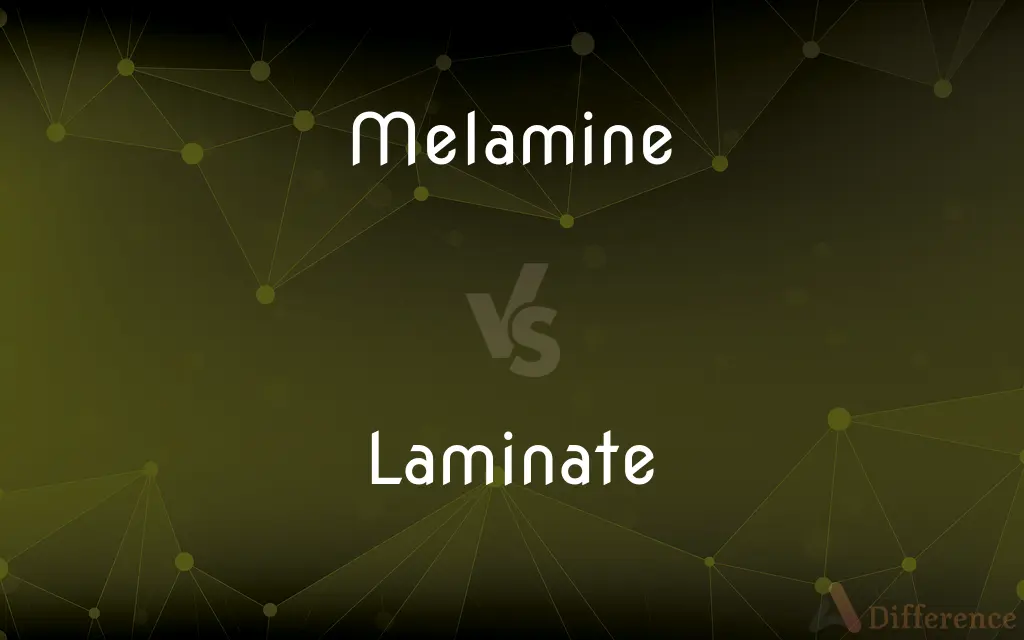Melamine vs. Laminate — What's the Difference?
By Urooj Arif & Maham Liaqat — Updated on March 21, 2024
Melamine is a type of laminate made from resin-infused paper, while laminate typically refers to layers of paper/wood and resin pressed together.

Difference Between Melamine and Laminate
Table of Contents
ADVERTISEMENT
Key Differences
Melamine is a specific type of laminate material known for its durability and resistance to heat and moisture. It's made by infusing decorative paper with melamine resin and applying it to a substrate like particleboard. On the other hand, laminate, in a broader sense, can refer to any material made by uniting two or more layers of material together. In the context of surfaces and countertops, it often involves multiple layers of kraft paper with a decorative paper layer, all bonded together with resin.
Melamine surfaces are recognized for their uniform appearance and affordability, making them a popular choice for cabinetry, shelving, and furniture in budget-conscious projects. Laminates, given their layered construction, can offer a greater variety of designs and finishes, including textures that more closely mimic natural wood, stone, or other materials.
The production process for melamine involves applying the resin-infused paper onto a substrate and then curing it under heat and high pressure, resulting in a hard and durable surface. Laminate manufacturing typically involves pressing together multiple layers of paper (including a decorative paper layer) and resin to form a dense, durable sheet that is then bonded to a substrate.
In terms of application, melamine is often used for flat surfaces such as cabinet interiors and shelving, where its uniform color and resistance to stains and scratches are advantageous. High-pressure laminates, due to their enhanced durability and variety of designs, are preferred for countertops, work surfaces, and areas subject to higher wear and tear.
While both materials are valued for their durability and ease of maintenance, laminates, particularly high-pressure laminates, tend to be more resistant to wear, making them suitable for heavier-duty applications. Melamine, with its cost-effectiveness and functional performance, remains a popular choice for residential and light commercial interiors.
ADVERTISEMENT
Comparison Chart
Composition
Resin-infused decorative paper applied to a substrate
Multiple layers of paper/wood and resin pressed together
Appearance
Uniform color and finish
Wide variety of designs, including wood and stone mimics
Durability
Durable, resistant to heat and moisture
Generally more durable, especially high-pressure laminates
Application
Cabinetry, shelving, budget interiors
Countertops, work surfaces, high-wear areas
Cost
Generally more affordable
Can vary, often higher due to more complex manufacturing
Compare with Definitions
Melamine
Made by infusing decorative paper with melamine resin.
Melamine-faced boards are common in kitchen cabinets.
Laminate
Comprises multiple layers, including decorative paper.
High-pressure laminates are used for durable countertops.
Melamine
Known for its consistent color and texture.
Melamine sheets offer a smooth, uniform finish ideal for interior shelving.
Laminate
Offers a broader range of finishes and textures.
Laminates can mimic the look of natural wood, stone, or metal.
Melamine
Suitable for kitchens and bathrooms.
Melamine cabinetry is resistant to steam and heat from cooking.
Laminate
Suitable for a wide range of uses, from furniture to flooring.
Laminates are used in both residential and commercial settings for their versatility and durability.
Melamine
Popular for budget-conscious projects.
Melamine is often used in affordable furniture and cabinetry lines.
Laminate
High-pressure laminates are especially wear-resistant.
Laminate flooring is known for its durability and longevity.
Melamine
Easy to clean and maintain.
Melamine surfaces can be cleaned with a damp cloth and mild detergent.
Laminate
Generally easy to clean, though some textures may require more care.
Textured laminate surfaces might need special cleaning methods to avoid damage.
Melamine
Melamine (listen) is an organic compound with the formula C3H6N6. This white solid is a trimer of cyanamide, with a 1,3,5-triazine skeleton.
Laminate
To cover with a thin sheet of material, as for preservation.
Melamine
A white crystalline compound made by heating cyanamide and used in making plastics.
Laminate
To beat or compress (metal) into a thin plate or sheet.
Melamine
A plastic used chiefly for laminated coatings, made by copolymerizing melamine with formaldehyde
A huge melamine coffee table
Laminate
To divide into thin layers.
Melamine
A white crystalline compound, C3H6N6, used in making melamine resins and waterproof coatings, for tanning leather, and as an additive to fertilizer to regulate the rate of nitrogen release. Melamine has also been used as an illicit and harmful additive to foodstuffs to increase the apparent amount of protein present based upon assays for nitrogen.
Laminate
To make by uniting several layers.
Melamine
A plastic made from melamine resin.
Laminate
To split into thin layers or sheets.
Melamine
(chemistry) A strong aromatic heterocyclic base, triaminotriazine, used in combination with formaldehyde to manufacture melamine resins; any such resin, such as Formica
Laminate
Consisting of, arranged in, or covered with laminae.
Melamine
A nitrogenous strongly basic chemical substance (C3H6N6), structurally 2,4,6-triamino-1,3,5-triazine, produced from several cyanogen compounds, and obtained as a white crystalline substance; - formerly supposed to be produced by the decomposition of melam. Called also cyanuramide. It is used as one of the starting components (together with formaldehyde) in the preparation of melamine resins, including the commercially marketed Formica (TM). It is solid at room temperature, and sublimes at temperatures approaching 250° C, decomposing at 345° C. Density 1.573.
Laminate
A laminated product, such as plywood.
Melamine
A white crystalline organic base; used mainly in making melamine resins
Laminate
A thin sheet of material, or the material itself, such as plastic, used to laminate something.
Laminate
To assemble from thin sheets glued together.
Laminate
To cover something flat, usually paper, in adhesive protective plastic.
We laminated the printouts so we could use them as signage.
Laminate
To form, as metal, into a thin plate, as by rolling.
Laminate
To cause to separate into thin plates or layers; to divide into thin plates.
Laminate
Material formed of thin sheets glued together.
Laminate
Consisting of, or covered with, laminae, or thin plates, scales, or layers, one over another; laminated.
Laminate
Consisting of, or covered with, laminæ, or thin plates, scales, or layers, one over another; laminated.
Laminate
To cause to separate into thin plates or layers; to divide into thin plates.
Laminate
To form, as metal, into a thin plate, as by rolling.
Laminate
To form by uniting two or more layers (in sheet form) of a material, so that the layers are bonded tightly.
Laminate
To unite (layers in sheet form) by bonding, so as to create a single object with multiple layers; - used with the material in sheet form as the object; as, to laminate plywood.
Laminate
To separate into laminæ.
Laminate
A sheet of material made by bonding two or more sheets or layers
Laminate
Create laminate by putting together several thin sheets of a material
Laminate
Press or beat (metals) into thin sheets
Laminate
Cover with a thin sheet;
Laminate the table
Laminate
Split (wood) into thin sheets
Common Curiosities
Is melamine waterproof?
Melamine is resistant to moisture, making it suitable for moist environments, but prolonged exposure to water can damage it, especially at seams or cut edges.
Can laminate materials mimic natural surfaces?
Yes, laminates can mimic a variety of natural surfaces like wood and stone, offering a wide range of design possibilities.
How durable are laminate surfaces?
Laminate surfaces, especially high-pressure laminates, are known for their durability and resistance to wear, making them suitable for high-use areas.
What is melamine commonly used for?
Melamine is commonly used for cabinetry, shelving, and furniture, particularly in budget-conscious projects due to its affordability and functional performance.
Can laminate be repaired if scratched or damaged?
Minor scratches on laminate can sometimes be repaired, but significant damage might require replacing the affected area or piece.
Can I use melamine for outdoor applications?
Melamine is not typically recommended for outdoor use as it can be affected by prolonged exposure to moisture and UV light.
What makes high-pressure laminate different from standard laminate?
High-pressure laminate is produced under higher pressures and temperatures, resulting in a denser, more durable material suitable for heavy-duty applications.
How does temperature affect melamine and laminate materials?
Both materials can withstand normal temperature variations, but extreme heat can damage laminate surfaces, and melamine can be sensitive to prolonged high temperatures.
How do I care for a laminate countertop?
Laminate countertops can be cleaned with a damp cloth and mild detergent, but they should not be exposed to excessive heat or harsh chemicals.
Can I paint over melamine or laminate surfaces?
Painting over these surfaces is possible but requires specific preparation and suitable paints to ensure adhesion and durability.
What substrates are used with melamine and laminate?
Common substrates include particleboard, MDF (Medium-Density Fiberboard), and plywood, chosen for their stability and ease of application.
Are melamine and laminate the same thing?
Melamine is a type of laminate, specifically a resin-infused paper applied to a substrate, while "laminate" can refer to a broader category of layered materials.
Are there health concerns associated with melamine and laminate?
Concerns mainly arise from the formaldehyde content in some resins used in these products, leading to regulations and standards for low-emission materials in indoor applications.
How environmentally friendly are melamine and laminate products?
The environmental impact varies by product and manufacturing process. Some products may use recycled materials or sustainable wood, but concerns about resin content and end-of-life disposal persist.
Is melamine suitable for cutting boards or food-prep surfaces?
While melamine is durable and easy to clean, it's not typically used for cutting boards or direct food preparation due to potential knife damage and hygiene concerns.
Share Your Discovery

Previous Comparison
Trajectory vs. Path
Next Comparison
Keynote vs. LectureAuthor Spotlight
Written by
Urooj ArifUrooj is a skilled content writer at Ask Difference, known for her exceptional ability to simplify complex topics into engaging and informative content. With a passion for research and a flair for clear, concise writing, she consistently delivers articles that resonate with our diverse audience.
Co-written by
Maham Liaqat














































